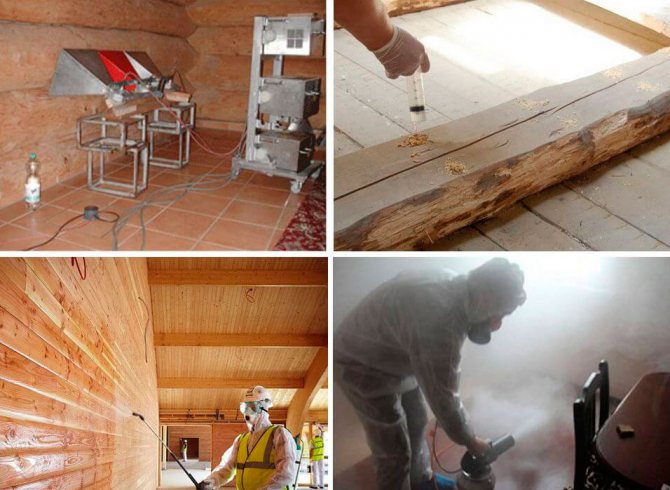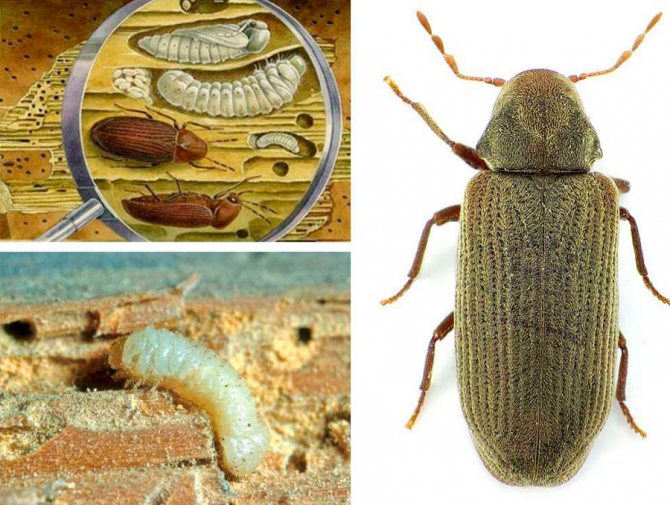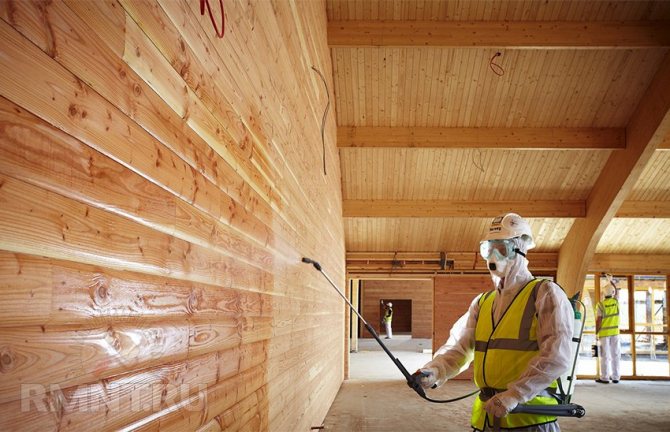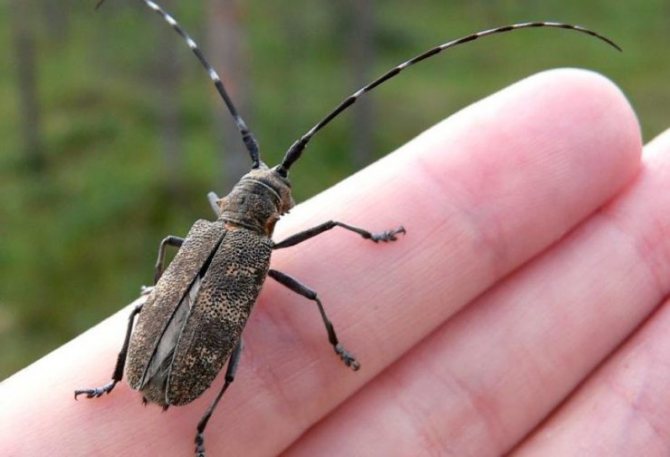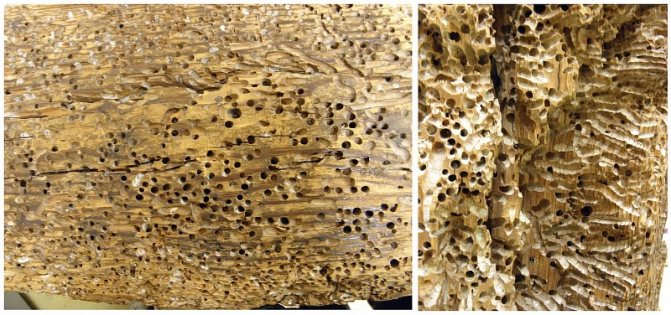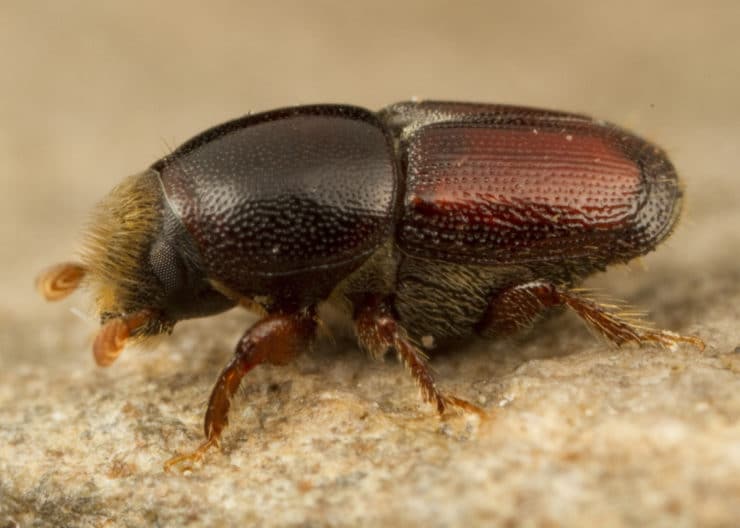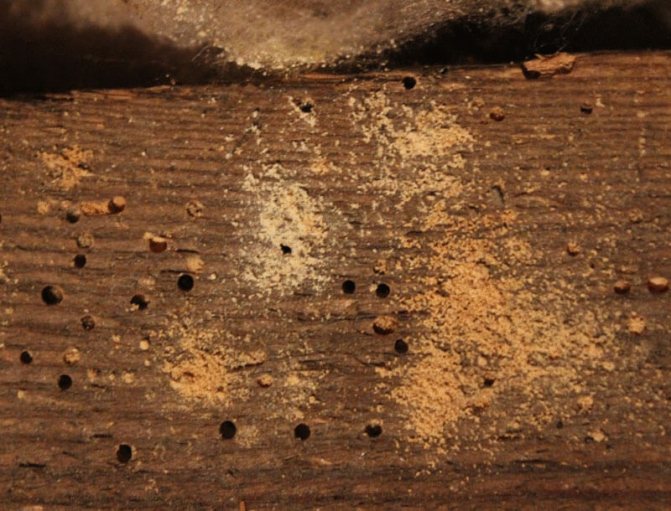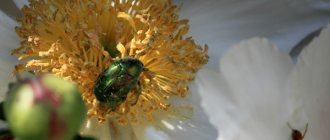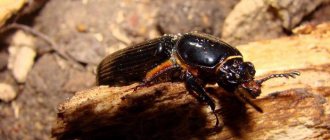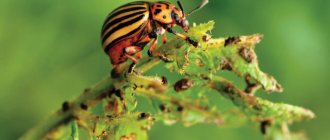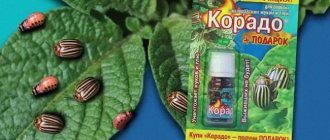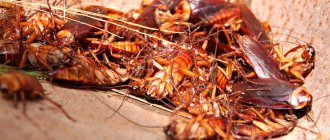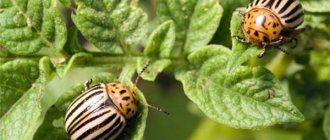Houses made of wooden beams attract many people with their environmental safety, as well as the fact that they have a special atmosphere of comfort and warmth. Furniture, dishes, wood crafts decorate the interior of any home and create a calm and comfortable mood in the house. However, during the construction of buildings and the production of furniture, additional processing of wood from pests is not always carried out, which leads to their premature destruction.

The reason that wood turns into dust and wood dust is that insects, parasites, often start in it, as a natural material. These parasites pose a great danger to load-bearing, supporting structures made of wood, since they are in danger of complete destruction, which will lead the house to an emergency state.
How to get rid of shashel
However, it is not the beetles themselves that are dangerous, but their larvae, which eat up the passages in the wood, due to which the tree, after a certain time, is transformed into dust.
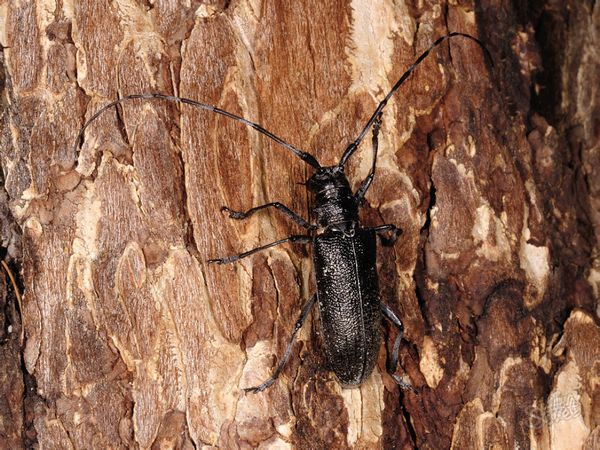

The larva gnaws wood, after which small holes remain on the tree, and after saturation, the larva gnaws a path to the surface, leaving a layer of protection no more than 1 mm thick. Then she again goes deep into the tree and prepares a place for future maturation and rebirth into a beetle. The larvae of various varieties of grinder beetles can inhabit from a couple of months to many years. Throughout this period of time, they cause irreparable damage to wooden products.
In Ukraine, there are two popular types of shashel: a furniture grinder and a house grinder. Both beetles are dangerous to any wood product. Regardless of the fact that large individuals can live in gnawed passages, they do not feed on wood. The main purpose of grinder beetles is reproduction. It is easy to identify the grinders, since during pairing they hit their heads against the walls of wood, as a result a sound similar to the ticking of a clock comes out, but it is very difficult to get rid of the grinder. You will be able to find the place of localization of the shashel at least by the characteristic sound. However, the discovery of large individuals indicates that the shashel in your home has long and managed to thoroughly ruin the tree.
HOW TO FIGHT WITH CHESHEL. Where to start? The fight against shashel in the house should begin with finding the place of residence of the bug larvae. To do this, carefully examine all furniture, floors, walls, if they are made of wood. By the way, upholstered furniture is no exception. Its internal parts are made of solid timber, thanks to which they can absolutely become a home for wood-borers. So sometimes you have to dismantle the sofa and armchairs in order to find housing for such pests. If you are purchasing a timber for construction, carefully review it. If holes are found, you need to abandon this purchase and order construction materials elsewhere, since it will be very difficult to cope with significant volumes of affected wood. The affected timber is not suitable for construction. For a certain time, only dust remains from the tree. If you find wood chips on furniture or garden trees, first treat the wood with fluorosilicate or sodium fluoride. These chemicals can be purchased at any gardening store. For use, dilute 250 g of the product in 12 liters of hot water. Stir and cool the water.Pour the solution into a spray bottle and spray on the fruit trees. If the kebab is wound up in furniture, soak a rag in this solution and wipe down all, even not contaminated furniture. all means are good in the fight against shashel. A mixture of creolin, paraffin, wax and turpentine helps to kill it. To prepare the product, you need to take 30 g of creolin, 50 g of paraffin, 1 liter of turpentine and 50 g of wax. Mix all the ingredients and finish the furniture with the resulting solution. On fruit trees, use a heated solution and apply with a brush. A turpentine-based solution will also help to remove the shashel. To do this, dilute 1 liter of petroleum jelly, 2 pieces of melted soap, 1 liter of gasoline, 100 g of naphthalene and 1 liter of kerosene in three liters of turpentine. Stir the anti-shashel thoroughly and wipe the furniture with a sponge, and go over the wooden structures with a brush. After such a finish, melt the paraffin and coat the passages with it. After seven days, repeat the treatment with the above solutions and lubricate the passages again. If the holes in the furniture are small, they can be covered with traditional Vaseline, and if it is possible to fill the passages with Vaseline. If the damage to the wood is excessively strong, you can leave the removal of the slab to specialists. Certain companies recommend removing the shashel using microwave irradiation. This variant of the fight against the grinder is especially reseltutative in case of damage to houses made of wood or wood trim indoors. Microwave equipment proved to be excellent. The irradiator is reliable and easy to maintain. The thickness of the finished structure can reach up to 25 cm. This makes it possible to kill the wood shashel even in very deep layers of wood. The advantage of this option is that the microwave equipment makes it possible to remove the wood from the wood under layers of clay, paint and varnish. This method of finishing wooden structures is not completely dangerous, since the irradiation is carried out using a remote control. After irradiation, no toxic chemical traces remain, and disinfestation can be carried out regardless of the season.
Destruction of the grinder beetle
The grinder beetle is a very common group of beetles that feeds not only on wood, but also on food products, is dangerous on an industrial scale and annually causes enormous harm to both individuals and businesses.
Eradication of the grinder beetle is challenging as this species is highly resistant to many of the modern poisons.
An additional inconvenience is caused by the species diversity of the beetle, therefore, when dealing with it, it is necessary to consult a specialist who can determine which type of grinder beetle has wound up in your house or warehouse.
The dimensions of the beetle are small, the average length is 5 mm, but individuals up to 1 cm are also found.
The danger is at all stages of development, in a year they are able to leave only a mountain of shavings from wooden floors or interior items.
How to find a grinder beetle?
The grinder beetle is nocturnal, so you shouldn't hope that you can catch it during the day.
Leaves characteristic through holes in the wood mass, but, as a rule, after going outside, it does not return to the old system of labyrinths, but proceeds to a new one.
Just as in the case of other tree pests, the grinder is characterized by sounds at night, similar to the ticking of a clock, thus, the beetle attracts the female.
At the sight of danger, the beetle pretends to be dead, which also complicates attempts to detect it.
Food grinders usually claim damaged items, packaging, food.
Larvae can often be found - small, yellowish-white in color.
In the larval stage, the beetle can live for more than 20 years, everything here depends on the conditions and typical characteristics.
How to get rid of a grinder beetle?
As mentioned earlier, before you get rid of the grinder, you need to determine its type.
Since each species has its own living conditions, for example, a house grinder prefers external wooden floors as housing, because he loves the cold temperatures that he needs for full development.
With the choice of means for extermination, the situation is even more complicated, since these pests are able to feed even on poisons, especially a grain grinder.
The most rational in this case would be to seek the help of Zarya's professionals, who will select the necessary method of struggle and save you from the grinder in a short time.
That will save you time, costs and hassles.
Most often, in the fight against the grinder, complex surface treatment is used with the help of fumigants, insecticides and the microwave method, which has today shown high efficiency in the destruction of pests that prefer to live in the thickness of the tree.
Complete destruction of the grinder beetle using modern means and equipment.
How to understand that a shashel has appeared in the house?
If you find wood dust in your house and hear a sound similar to the ticking of a clock, which comes from the wall of the building, then most likely pests have appeared in your house. Wood dust is a characteristic sign of the appearance of roe larvae, which they leave after eating wood.
And the sound of a ticking clock makes a shashel during mating, as it hits its head against the walls of the passage, into which it will later lay eggs. These are the most characteristic signs of the appearance of a shashel in the house.
Once you find these signs, it is worth taking immediate action to eliminate wood pests.
Reasons for the appearance


This pest can appear in the home for a number of reasons:
- When already contaminated wood is used during the construction phase of a building or structure.
- The use of old, unkempt wood, with cracks and crevices.
When wood is harvested in the forest, it can be stored on the site for a long time. This is a fertile breeding ground for woodworm beetles. If we take into account the high humidity, then these are ideal conditions and all the beetles simply flock to this place to lay their eggs. After that, various structures are made from this tree. If the tree is not processed, then the larvae emerging from the eggs will immediately begin to destroy the wood, or rather the products made from it.
Shashel larvae
The development of the larva in the egg is completed in one to four weeks. Immediately after that, she begins to devour wood. From the laying of eggs, a passage begins, which the larva gnaws. Gradually the larva grows and changes, molts and at the last stage of development it grows up to 4 mm long and up to 2 mm wide.
The larva lives for 2-3 months, or up to several years, it all depends on the type of insect. At the last stage, the larva goes inside the wooden structures and pupates there. The adult is ready to lay eggs again.
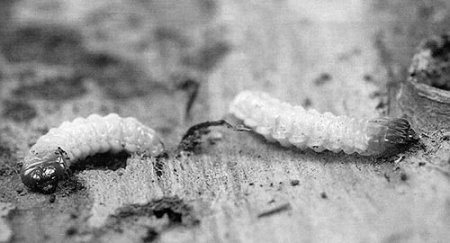

The destruction of the shashel
Shashel beetle with this name does not exist, this word is borrowed from another language (grinder, woodcutter, sawfly, bark beetle, lumberjack) one of those pests that in a short time will not leave a trace of wooden elements in your house, all that remains is to collect wood dust in scoop.
Therefore, the destruction of the shashel is a necessity in case of suspicions that it is wound up.
The beetle's favorite habitat is wooden structures; any type of wood is to his taste.
The beetles themselves do not feed during their entire life, the main harm is caused by the larva, which, during its larval stage, makes holes in the wood pulp up to 12 km long.
The size of the larva is only about 4 mm, but during its life it manages to inflict tangible harm.
The characteristic habitat of shashel is any room inside which there are wooden structures and interior items, the beetle does not like to settle outside, it prefers a home environment, like you.
Therefore, the main goal of the new inhabitant of your home is: parquet, wardrobes, wooden tables, chairs and other items.
It is not difficult to find out that you have got a barbecue; usually, a larva eating a tree makes a characteristic ticking sound.
It will not be easy to spot it, however, you can find an egg laid by a female on the surface.
It is attached to the outside of the wooden sheet and the larva continues its path after birth immediately into the thickness.
Therefore, removing the shell of the egg, you can see a small hole, with a characteristic dust mixed with the feces of the pest.
It should be noted that not all larvae are reborn into beetles in the first year of life, and it is not uncommon for the larval stage to drag on for up to 3 years.
During this time, only one larva will cause irreparable harm to a wooden object.
Which will be impossible to restore.
Folk remedies to combat shashel
Folk remedies are solutions that are proposed to be used for treating wooden surfaces.
The first variant of the mixture
... You need to take 10 liters of hot water and 250 g of sodium chloride. The resulting solution is sprayed onto wooden surfaces with a spray gun.
Second option
: you need to take 10 liters of lime turpentine and 300 g of creolin, add a pound of wax and paraffin. Next, mix until smooth and grease wooden structures.
Professional preparations for the fight against shashel
Commercially made drugs are much more effective. Among them I would like to especially highlight "Anti-bug"
... It is an antiseptic that pests of wooden surfaces are afraid of. The agent affects not only adults, but also larvae. It is not dangerous for humans and for the appearance of furniture and decorative items.
"Antishashelin
»Intended for the destruction of wood pests. It is a solvent in which silicone solutions are present. This solution has a good ability to penetrate into the wood, it can handle both young and old, dry wood. It is widely used in parquet, antiques, furniture and flooring applications.
Professionals widely use a drug called "Drevotex"
... Its main advantage is the effect on the pest within six months after applying the product. A favorable time for treatment with this tool is the period from July to January. To exclude the appearance of new larvae, it is worth processing the constructions at intervals of every three months. "Drevoteks" is injected into the passages with a syringe and covered with petroleum jelly or wax.
One of the topical means is professional fumigation. Gas treatment is especially effective, in which the active substance does not harm others, but also penetrates deeply into all layers of wood. In this case, both adults and all larvae die at any stage of development.
For people, gas is harmless and allowed for processing food, however, in order for this method to work effectively, it is necessary to leave the treated room hermetically sealed for about 3-4 days. After that, the specialists of the fumigation company ventilate the room, and it becomes safe for people. The advantage of this treatment for parasites is that all insects die without exception.
Why is shashel dangerous
The imagos pose no threat. The beetle is not able to bite a person and does not cause an allergic reaction. But its larvae do serious damage to the wood. They are capable of destroying an entire tree in a short period of time.The insect often destroys wood products. It is often found in wooden houses and buildings.
The main problem is that it is quite difficult to notice the shashel in the early stages. By the time the pest was finally identified, it usually had already done a lot of damage to the wood. In addition, it is almost impossible to completely get rid of a large colony of beetles without the help of specialists.
Signs of infection
Over time, holes appear in the affected wood, from which yellow-gray dust falls out. These are feces and food debris with which the larvae seal the tunnels. Infection can cause wood to rot. Adult beetles can sometimes be found outside of hiding places. Most often, they fly openly around the premises during the breeding season. At the same time, at night, you can hear sounds resembling ticking.
How to get rid of bricks in the floor, in furniture and in rafters, beams
The arrangement of floors in houses allows for infection with shashel, which often happens. Logs, subfloors - boards or parquet can be infected. It should be noted that Italian parquet is eaten the same way. Again, colonization with woodworms could occur both at the stage of board production and during operation. Poor or long-standing (after all, it is required every 3-5 years) processing of wood with repellents of repelling insects. Again, dampness from the underground space, so a mistake during construction will attract both mold and a woodworm beetle. Which will make life in the house simply impossible.
But do not be immediately scared, having microwave equipment Shashel.no, this problem is solved quickly and reliably. No need to disassemble the floor, change the lags,
rough boards and parquet, especially since this is an extremely expensive pleasure, which entails a lot of repairs. In cases where the top layer of the flooring device is not infected and it is required to process logs or rough boards, the exterminator easily copes with this problem. After all, the peculiarity of the microwave field lies precisely in its high penetrating ability and selectivity in the process. By aiming the screen at the infected area, simply placing the equipment on the floor, woodworm larvae will be destroyed along the entire depth of the floor device. Again, the wood will be dried, removing a favorable environment for mold or the Barbel beetle, if it had a place to be.
In cases where the base is a concrete monolith through insulation and only on top we have wood in the form of parquet, the problem is solved in the same way, because expanded polystyrene is radio-transparent materials and will not interfere with us.
And the same process occurs for interfloor floors, where wooden beams will be possible. The shashel is destroyed quickly and without disassembly and expensive repairs.
Shashel in furniture
Most of the furniture is made of wood. This also makes it susceptible to woodworm infestation. Here one encounters a furniture grinder or a watchmaker beetle. The English name Deathwatch beetle was given to him for the characteristic sound made by a gnawing larva, the tick of a clock that measures the time to death. The furniture grinder loves dry wood, leaves very small holes, and its larva has a very long period of development, up to 15 years. If you find signs of a furniture grinder, it is not worth pulling with destruction, because contamination can easily spread to other wooden objects in your home. It can be, like other furniture, as well as doors, window frames and parquet. The furniture grinder eats thoroughly from the wood only dust remains.
Infection with a grinder beetle can be both natural and acquired immediately with furniture. Often this is the sin of furniture from the Middle Kingdom, this is how wood pests come to us that are not at all characteristic of our latitudes, but in a warm room they already make no difference. So with exotic and beautiful wood, woodworms are also acquired, which can pretty much spoil and even simply destroy furniture.There have been cases of existing infection in furniture fronts for the kitchen. The Italian chipboard, for all its seemingly unattractiveness for furniture grinders, was infected with woodworm.
For such cases, the company Shashel.net has equipment for restorers. The lightweight and reduced emitter allows pest control even in the most difficult cases. With such equipment it is possible to process antiques, icons and more. A gentle and precisely dosed microwave field will act exactly on the woodworm larvae, without disturbing the structure of the wood and without destroying antiques. Nails or any other metal furniture fittings do not affect the processing process or the equipment itself. Thus, the furniture will be saved and the grinder beetle is destroyed quickly.
Shashel in the rafters. Woodworm on the roof.
Low-rise private construction has been gaining popularity since the collapse of the USSR and the arrival of private property. Each person wants to have his own home and be the owner in it. And the device of the roof in houses is often made from a wooden rafter system, which is very tasty for a shashel. Warm attic spaces with an abundance of timber make for almost ideal conditions for woodworms all year round. And a new careless owner of the attic may appear - Shashel. It ends sadly: the roof, the rafter system lose strength over time, it bends under its own weight, the tightness is broken, and if this process is not detected and stopped in time, the roof will collapse.
During construction, it is necessary to monitor the quality of the forest used, treatment with preventive fire-biological protection, which, by the way, must be repeated every few years, otherwise the trouble will not be avoided. Replacing the rafters, equal to the entire roof, is an expensive process. Which is better to warn. If the infection is still detected. Action is required immediately. For such situations, there is microwave equipment that allows you to quickly destroy the woodworm. A specially developed system allows processing even in the most difficult conditions.
Destruction of the bark beetle
Bark beetles belong to the subfamily of weevils and are another unpleasant neighbor for humans.
This pest with a great appetite absorbs both wooden structures inside the house and living garden trees on the plots.
That is why, the destruction of bark beetles is a rather difficult task, unbearable for independent struggle.
The size of an adult beetle does not exceed 9 mm.
Unlike shashel, where only the larva causes harm, the bark beetle is a pest at all its life stages, its life mainly takes place in wood pulp.
There they lay eggs, feed, go through the pupa and larva stages and leave the thickness of the tree only once for fertilization, after which they return to the place that they have chosen as their home.
The bark beetle has a peculiar nutritional system.
The tree serves him only as a home for normal life, for a day the larva turns 10 grams of wood into dust.
The pest feeds on the mycelium, which grows in its moves.
Because of this, the harm caused by the beetle is doubled, since in addition to mechanical damage to the wood by the bark beetle, it is additionally destroyed by the mycelium, the spores of which are brought by an adult on its paws.
How to find out that the bark beetle has started?
If you have any suspicions that a bark beetle has started, then carefully examine the wooden objects in the dwelling.
You can always find a characteristic hole in the strata with a diameter of about a centimeter, as a rule, there is drill flour near it, which crumbled outward when making a stroke.


The color can be different from brown to light yellow, it all depends on the depth to which the move was made.
In addition to visible signs, the bark beetle emits characteristic sounds during making moves, similar to ticking.
If the bark beetle has wound up in your garden, then another sign is a characteristic pattern under the bark of a tree, similar to a topographic map, for which the beetle is called a topographer.
How to deal with bark beetle?
With the variety of products on the market today, the fight against the bark beetle is still a rather difficult matter, since the beetle is not so easy to detect, and even more so to remove from the tree mass.
And even if you manage to get the beetle out, then the question with the mycelium is more complicated.
It is practically unaffected by chemicals and will continue to attract new individuals, even a month will pass before the beetle starts up again.
The specialists of the Zarya company have a comprehensive approach to the destruction of the bark beetle, in addition to treating the wood with insecticides and fumigants, we use a modern microwave method, which is able to destroy not only the bark beetle in all stages of maturation, but also the mycelium, which serves as a bait for new individuals.
It should be noted here that the most effective and economical prophylaxis against the bark beetle, therefore, when buying a wooden structure, it will be more rational to process the house in advance, this approach will save you from many problems in the future.
Complete destruction of the core with the help of modern means and equipment.
HOW TO GET RID OF THE CHASSEL
Shashel (woodworm) is a medium-sized beetle.
However, it is not the beetles themselves that are dangerous, but their larvae, which eat up the passages in the wood, because of which the tree eventually turns into dust. The larva gnaws wood, after which small holes remain on the tree, and after saturation, the larva gnaws a path to the surface, leaving a protective layer no more than 1 mm thick. Then she again goes deep into the tree and prepares a place for subsequent ripening and rebirth into a beetle. The larvae of different types of grinder beetles can live from several months to several years. During all this time, they cause irreparable damage to wood products.
In Ukraine, there are two types of shashel: furniture grinder and house grinder. Both beetles are dangerous to any wood product. Despite the fact that adults can live in gnawed passages, they do not feed on wood. The main purpose of grinder beetles is reproduction. It is easy to calculate the grinders, since during the mating period they hit their heads against the walls of the wood, the result is a sound similar to the ticking of a clock, but getting rid of the woodworm is quite difficult. At least by the characteristic sound, you will be able to determine the location of the shashel. However, the discovery of adults suggests that the shashel in your home has long and managed to pretty much spoil the tree.
How to deal with shashel. Where to begin?
The fight against shashel in the house should begin with finding the habitat of the beetle larvae. To do this, carefully inspect all furniture, floors, walls, if they are wooden. By the way, upholstered furniture is no exception. Its inner parts consist of a solid bar, so it may well become a home for a woodworm. So sometimes you have to disassemble the sofa and armchairs to find a home for these pests. If you buy timber for construction, take a close look at it. If holes are found, discard this purchase and order building materials elsewhere, as it will be very difficult to cope with large volumes of affected wood. The affected timber is unsuitable for construction. Within a few years, only dust will remain from the tree. If you find wood chips on furniture or garden trees, be sure to treat the wood with fluorosilicate or sodium fluoride. You can buy these chemicals at any gardening store. For use, dilute 250 g of the product in 12 liters of hot water. Stir and cool the water.Pour the solution into a spray bottle and spray on the fruit trees. If the kebab is wound up in furniture, soak a rag in this solution and wipe down all furniture, even not contaminated. All means are good in the fight against shashel. A mixture of creolin, paraffin, wax and turpentine helps to kill it. To prepare the product, take 30 g of creolin, 50 g of paraffin, 1 liter of turpentine and 50 g of wax. Mix all the components and treat the furniture with the resulting solution. On fruit trees, use a heated solution and apply with a brush. A turpentine-based solution will also help to remove the shashel. To do this, dilute 1 liter of petroleum jelly, 2 pieces of melted soap, 1 liter of gasoline, 100 g of naphthalene and 1 liter of kerosene in three liters of turpentine. Stir the anti-skewer thoroughly and wipe the furniture with a sponge, and go over the wooden structures with a brush. After such treatment, melt the paraffin and coat the passages with it. After a week, repeat the treatment with the above solutions and lubricate the passages again. If the holes in the furniture are small, you can cover them with ordinary petroleum jelly, and, if possible, fill the passages with petroleum jelly. If the damage to the wood is too strong, you can entrust the destruction of the shashel to professionals. Some firms offer to destroy the barbecue using microwave irradiation. This method of dealing with a grinder is especially effective when attacking wooden houses or indoor wood finishes. Microwave equipment has proven itself perfectly. The irradiator is reliable and easy to use. The thickness of the structure to be processed can be up to 25 cm. This allows you to kill the slab even in the deepest layers of wood. The advantage of this method is that the microwave equipment makes it possible to remove the wood from the wood under layers of clay, paint and varnish. This method of processing wooden structures is absolutely safe, since the irradiation is carried out using a remote control. After irradiation, no toxic chemical traces remain, and disinfestation can be carried out at any time of the year.
Means for combating shashel
You can treat wood from shashel using industrial insecticides. The most effective among them are:. Antizhuk. Antiseptic for wood Antizhuk is designed to kill insects that damage wooden surfaces. Moreover, the insecticide kills not only adults, but also their larvae. It is also used to prevent wood grinders from contaminating wood surfaces. Antizhuk can be used for both indoor and outdoor work. Often this tool is used as a preventive measure to prevent the appearance of grinders. The chemical does not change the decorative coatings of the materials and is not highly toxic to humans. .Anti-shashelin. Also designed to control woodworms. The insecticide is used to impregnate both old and young wood. Antishashelin is a solution of silicones in an organic solvent, therefore it has a high penetrating ability. It is used to kill adult grinder beetles and their larvae. The tool is used to destroy pests in joinery, parquet, antiques, furniture, wooden buildings and floors. .Drevotox is one of the most effective insecticides. Wood impregnated with this chemical remains toxic to rock for six months. Drevotox can be used all year round, but in the period from June to January its effectiveness is slightly higher. Contaminated furniture should be treated several times at intervals of three weeks. Drevotox should be injected into the cracks and passages eaten by the grinder using a pipette or syringe. If the tree is too badly damaged by the shashel, it should be completely lubricated with a solution with a brush. To prevent the insecticide from evaporating and leaking, cover the treated holes with paraffin or wax. .Empire 20.Treating wood with the Empire 20 insecticide is a simple, but at the same time, reliable way to kill domestic insects, even with a strong infestation. Despite the fact that Empire 20 effectively destroys shashel and other insects, its toxicity to humans and animals is negligible, so this drug was not even included in the classifier of hazardous chemicals approved in the EEC countries.
How to determine if a tree is infected
The most terrible scourge of wood is termite, bark beetle and woodworm (woodworm). Wood beetles act swiftly and render wood unusable in 2-3 seasons. The termite colony destroys the rafter system in 1–2 seasons. It is because of the speed of movement and omnivorousness that tree beetles can be "infectious", that is, they can move to a clean, uninfected forest and lay larvae.
This pest is also called "grinder beetle". However, it is not the beetle itself that is dangerous (adults do not live long and do not feed on anything), but its larva. Shashel larvae have a loose structure and developed jaws, with which they grind wood fibers, using nutrients from them.
Bark beetle
This beetle also feeds on oxidized wood - the most “tasty” areas for it are in the place where the bark adheres to clean fibers.
Insects live in large colonies with excellent organization. The species diversity of these insects is striking - about 3000 species. A distinctive feature of termites is that they move hidden, making passages underground or in the body of wood. Therefore, the termite mound, arranged in a wooden structure, is invisible in appearance.
Lumber affected by insects has characteristic differences:
- visible remnants of passages under the bark of the wane - bark beetle;
- abnormal lightness of the board, holes Ø 2–5 mm on the surface, while the board looks intact, there are no moves - termite or shashel;
- wood flour (dust), sometimes black-brown - all insects.
Wood affected by pests is "not cured", since insects always strive to capture the largest space and are distributed throughout the entire element or structure, as long as their number is enough. If you find signs of a beetle, you should refuse to purchase the material. If the beetle is found in available stocks, discard the material and incinerate the contaminated items.
The presence of larvae in the operating structure can be determined by ear - they emit a characteristic grinding or tapping, biting into a tree. In the old days, this sound was called "the clock of death", since practically nothing was known about the possibility of a struggle.
All methods of countering wood insects can be divided into preventive and operational.
This category includes actions for the preliminary processing of lumber, that is, before it enters the building structure. These methods prevent the formation of fungus and make the wood unsuitable for insects.
On-site antiseptic treatment. The simplest, cheapest and at the same time the weakest method of protection. Usually, the composition is simply applied to the surface of the wood at the storage location or immediately before use. For ease of use, you have to "pay" for a small penetration depth - up to 1 mm. Moreover, any antiseptic has a validity period, usually from 1 to 5 years. After 5 years, any antiseptic is guaranteed to be neutralized and the structure requires re-treatment.
Heat treatment. This method involves heating in sealed heat chambers. In this case, the products warm up to 140 ° C, but the oxygen deficiency prevents the wood from igniting. The body of the tree is disinfected and nutrients for insects (sugar, starch) disintegrate, such a tree is no longer "interesting" to them.
Autoclave. The most effective way to disinfect and antisept wood is autoclave impregnation. It is used when processing the most valuable products - laminated veneer lumber and glued beams.The product is placed in a sealed container filled with an antiseptic, which is then supplied with pressure up to 100 atm.
These methods are used in emergency cases - when the beetle has already wound up in an existing structure. These measures do not give 100% of the effect, rather, we are talking about 50% of cases when it is possible to stop the development (reproduction) of insects. If it is not possible to replace the element, then both old "old-fashioned" and modern technological methods will come to the rescue.
Injection
The most time consuming, but quite effective way of dealing with larvae. To implement it, you will need the main chemical - a solution of sodium fluoride or silicofluoride, which can be purchased at a fertilizer store. The method is applicable if inlets are available.
- Prepare a solution of sodium fluoride - 250 ml of concentrate per 3 liters of water.
- Clean and blow through the inlets with a syringe.
- Prepare gruel from bread and concentrate.
- Using a syringe, inject the solution into the larva's course.
- Seal the hole with poisoned bread putty, if possible, so that the solution stays inside.
- Cut off the side wall of the microwave oven opposite to the magnetron (usually located on the wall with the control panel).
- Determine by ear and mark the location of the larvae with a marker.
- Install the device, directing the open part (socket) to the site of the larva injury. The gap between the socket and the wood surface is 20–30 mm. The device must be connected in an adjacent room.
- Set the timer for 20 minutes and go to the adjacent room to connect the device.
- Plug in the device and wait 20 minutes.
- After the shutdown timer has expired, move the device to the next maintenance point.
Spraying will wash the wood flour off the course. Solution vapors and impregnated walls of the passage will force the larva to look for an urgent (during the day) exit and it will try to crawl back along the familiar passage. To get out, she will need to gnaw through a cork of poisoned bread. Everything. It looks like a fairy tale or a comic strip, but the method was invented and promulgated by a biologist-summer resident.
Tapping
If a shashel or bark beetle is wound up in the floor or a wooden wall, such a simple method as tapping will help. It is quite effective, especially if there are no entry holes on the visible surface. It is better to tap a plane or structure through a block so as not to leave marks from a mallet or hammer. The harder and more often you work on the bar, the better the effect will be.


The larvae of shashel, bark beetle and termite are 85% moisture, have a loose structure and are not adapted to vibration. The water, vibrating from the impact in their soft shell, simply tears them apart, leaving only mucus. Practice has shown that in places where the larvae die, new insects do not start.
Microwave processing
In the moisture of which the larvae are composed, processed nutrients are dissolved, in particular protein, which coagulates when heated to 56 ° C. In other words, if the structure is only heated to 58–60 ° C, any larvae will die, since the protein in them will simply curl up. It is not possible to heat the structure using traditional methods, but modern technology makes it possible to do this with the help of microwaves, which are used in the familiar household microwave oven.
To implement the method, you will need a working microwave oven, which will be irrevocably converted into a unit for combating woodworm. Considering the 100% efficiency of the method and its harmlessness, this is a small price to pay.
Attention! Any protein, including the eye protein, is curtailed from invisible microwaves. Being in the same room with a working device is extremely dangerous. Being in the next room is absolutely safe.
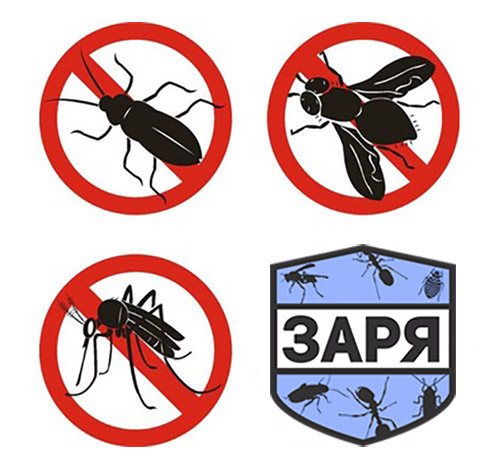

Video on how to get rid of skewers in beams with a microwave
The most effective method will be continuous prophylaxis - wave treatment of the entire structure.
Description of appearance
In our area, there are several types of shashel - furniture, brownie.Each of these pests causes significant damage to wood structures, furniture, even books and leather goods. What a shashel looks like, many people know, but do not realize that this is it:
- an elongated body with a strong shell;
- brown or black color;
- the size of the pests is several millimeters;
- on the head there is a long curled mustache with a strip;
- three pairs of long, rather powerful limbs.
The woodworm itself is harmless, does not pose a danger to life, human well-being. But living with him under the same roof threatens serious damage to property.
The shashel larva is a thick, dirty yellow caterpillar with a well-developed mouth apparatus. It does not leave burrows, so it is problematic to see it. But the presence of characteristic sounds give out.
The photo of the shashel is presented below, you can clearly see all the features of the structure of the body, the color scheme.
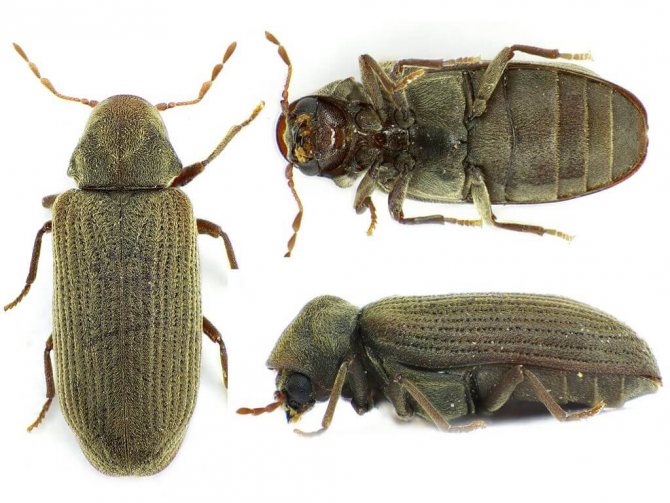

Shashel
Recommendations for the use of wood
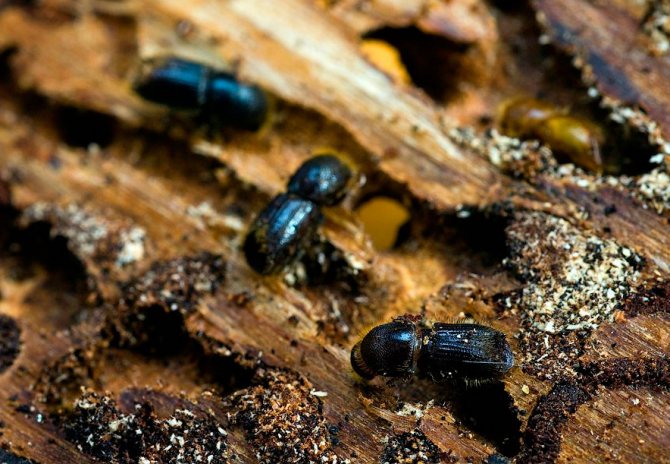

It must always be remembered that it is very difficult to deal with wood-boring beetles, therefore, measures must be taken in advance to preserve the wooden structures intact. There are a number of recommendations that can significantly extend the service life of wooden structures. For example:
- At least once a year, inspect wooden structures for the presence of woodworm beetles and their larvae.
- Construct buildings only from dry, processed wood.
- If this is not possible, then wood structures can be processed independently. For such purposes, it is better to use products with prolonged action.
- All wood structures should be handled, including window frames, doors, floors, roof frames, etc.
- If contaminated wooden structures are found during operation, it is better to replace them and burn the old ones.
Woodworm beetle poses a serious threat to timber structures. The thing is that he spends the main part of his life in the thickness of the wood, rendering it unusable. In order for wooden structures to serve as long as possible, they need to be treated with special compounds, after which they need to be monitored every year.
Features of life
The presence of shashel in a tree is indicated by a specific sound similar to the ticking of a clock, chirping. It is reproduced during the mating period of beetles. You should look for them on the surface of the wood. Since at the time of mating, woodworms leave their burrows.
The sound determines the location of the nest, as well as the degree of infection. The more intense and louder the ticking, the more pests in the house. Another characteristic sound is created by the larvae, which gnaw wood with a special appetite day and night. The minks are filled with excrement, which crumbles over time, resembling sawdust, wood dust.
Adult beetles spend most of their lives in the nest, making more and more moves in different directions. But the main pests are the larvae, which do not leave the holes at all.
Infection of a house occurs during construction, when using material with larvae, roe eggs, in old wooden houses with cracks in the wall, window sills, doorways. And also in the new construction, if no attention was paid to the careful processing of the wooden components.
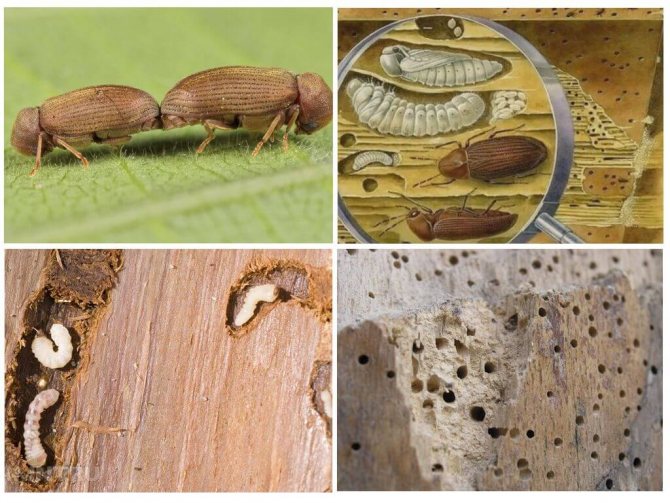

Features of the life of shashel
Features of shashel
The first sign of the presence of shashel in a dwelling is a subtle creak of wood, after which wood dust appears. When buying a house or before starting construction, many people choose wood as the main material, since it is considered the most environmentally friendly.
Even if the main structures are made of synthetic materials, there are still wooden structures, furniture, and various decorations in the house that create a special atmosphere of coziness and comfort. For this reason, it becomes necessary to think about the invasion of pests. They are the woodworm beetle or shashel.
Appearance
Belongs to the family of grinders.The insect is very small in size. Its length reaches only a few millimeters (3-4), for this reason, the primary signs of their habitation in your home are invisible. Shashel is often confused with midges, since the insect can fly. The color of an adult insect ranges from black to dark brown.
It has a pair of antennae and three pairs of legs, usually lighter in color than the body. Its shell is very dense, covered with fine hairs. Several well-defined longitudinal furrows run on the upper rigid elytra. The body is cylindrical with a small head.
The larva resembles a thick worm, the body of which is segmented. Has a yellow color. Very powerful jaws can be seen on the brown head. The larva can only be observed after sawing a board or log. In life, she does not leave her burrow.
Life cycle and reproduction
Such characteristics as wood species, color, shashel format are not of interest. For life, a five-year-old tree, which has low humidity, is suitable for him. Getting on the surface of the board, the beetle quickly bites into it and begins to dig holes in order to lay eggs faster. The first signs of destruction are visible already 12 months later, after its penetration into the dwelling.
Reproduction in the beetle is very accelerated. One female lays up to 80 eggs at a time, after which they beneficially turn into larvae. The greatest harm is caused by the beetle in the larval stage. It is a known fact that one larva lives for about 7 years and breaks through tunnels over 40 km long.
The larvae swarm passages with waste material and fill them with their excrement.
After drying, this content spills out and spoils the aesthetic appearance of the tree. During the journey, under favorable conditions (dryness, high temperature, darkness), the larva looks for a place for itself, where it subsequently turns into a pupa.
Features of shashel:
- An adult exists for only a week to one month. It is necessary for the reproduction of the genus.
- The egg turns into a larva in 12-15 days.
- After the appearance of the larva, several molts occur. The last capsule is about 4 mm in size. In this case, the beetle is 2 mm in size.
- All stages make up a time period of two years. The larval stage is considered the longest.
Only the shashel larva is capable of damaging more than half of all lumber.
How the shashel enters the home
The main reasons for the appearance of woodworm in the house can be:
- Use of untested lumber in construction.
- Using old wood that has cracks and crevices.
- Improper storage of wood in warehouses that become unsuitable for building and repair.
- Purchased furniture with shashel grubs.
The first signs of a pest are usually not visible, but after the onset of symptoms of his stay in the house, it becomes very difficult to cope with the insect. Therefore, if the house is already built or there is homemade furniture made from damaged material, try to carefully inspect the wood for holes and damage every time you do a general cleaning.
Important! When choosing a forest for construction, examine the forest. They should be free of bark and visible holes, beetle entrances.
Measures to combat shashel
To start fighting the enemy, it is necessary to determine the location of its location, for this you need to examine the wooden partitions on the ceiling, floor, window sills, doorways, all furniture made of wood.
You should pay attention to upholstered furniture, the frame of which is also made of pressed sawdust or wooden beams. You can easily determine if a sound is heard that resembles a clock or a light tapping. Such sounds are typical for adults during mating, which occurs on the surface.
After you managed to find an unpleasant neighbor, you need to start destroying them.The choice of the method will depend on the capabilities of the tenants in terms of finances, time and effort.
Video: Fighting against shashel in books, antiques
Chemicals
The proven and most popular broad-spectrum insecticides are used:
- Antizhuk - is able to eliminate not only adult wood pests, but their larvae. It should be treated twice with a break of two weeks. The drug is not toxic to residents of apartments and houses, but it must be used using personal protective equipment.
- Antishashelin. The preparation contains active silicone, which penetrates inside and kills the larvae of shashel. Does not spoil the look and is used for any items made of wood, including antiques.
- Drevotex has a long-term effect, which persists after the complete expulsion of the parasite for another six months. It can be used as a prophylaxis. But its use is quite troublesome, since the treatment should be carried out several times a year, every three months. The procedure is as follows: a syringe is filled with the agent, then poured into the holes that are visible from the outside, after which these passages should be sealed with paraffin. Processing is carried out both in summer and winter.
- Lignofix is another very effective drug against shashel and its larvae. Its action will be prolonged for 10 years. It has the effect of infection, getting on the surface of the parasite, penetrates and affects all important systems of life, leading to complete death.
- Empire - 20. Non-toxic to pets and humans, capable of destroying the largest populations of shashel in your apartment.
In any case, the choice is yours. If you are at a loss to choose an antiseptic or insecticide, you can ask a shop assistant for help.
Larval development
In the egg, the barnacle develops from 1 to 4 weeks. The first stage larva is a caterpillar. Begins to sabotage immediately after birth. Gnaws through numerous moves. Molt periodically, gradually increases in size. The larva of the last stage reaches 4 mm.
How long the shashel beetle lives in the larval phase is difficult to say. According to various sources. develops in the conquered territory from 3 to 15 years. At the last stage, it goes deep into the tree, pupates. It comes to the surface as a woodworm already formed by a beetle. But after mating, it returns to the tree again to build a nest, lay eggs.
Shashel is the main enemy of wood
One of the most dangerous pests that live in the tree is shashel. It is a delusion to think that this pest can live in cereals or other food products. This carpenter beetle of black or dark brown color is small (its length is 3-4 mm), it can even be confused with flies. But to be sure whether this pest has started up in the house, it is advisable to know what a shashel looks like, photo below.


The beetle often chooses wood with a 5-6-year service life and spoils it very quickly, after a year the result of his actions is noticeable to everyone. When a shashel beetle hits a wooden surface, it instantly reads to bite into it in order to create passages and lay eggs in them.
The roe larvae also threaten the integrity of the wood, they gnaw out long tunnels and densely clog them with digested pulp and their own excrement. Then they try to find the most comfortable place in the tree, relative to the temperature, where they pupate. This pest beetle multiplies with great activity. Females lay about 80 eggs in their nest, from which larvae emerge.
The larva can live in wood for up to 7 years (in some cases up to 15 years) and drill about 40 km of holes during its stay. It is considered to be the main culprit in timber damage.
Control methods


Insect Control Methods There are several methods to get rid of woodworm.The choice depends on the degree of infection, financial capabilities, personal preferences.
- Insecticide treatment. Antiseptics, broad-spectrum drugs are used.
- The use of folk remedies. A special mixture is prepared, which blocks the access of oxygen to the larvae, adults, and causes death.
- Exposure to microwaves. It is carried out by specialists using modern equipment. The generator generates microwaves that are directed towards the infected wood. It warms up, kills the larvae of the shashel, beetle. The disadvantage of this method is laboriousness and high cost.
- Dry steam treatment. The action resembles the previous method. Dry steam heats the wood and reduces humidity. In such conditions, the larvae of the roe and the beetles themselves die.
- Fumigation - fogation, fumigation. Phosphorous hydrogen is used, which is able to penetrate into the deep layers of wood, destroy the larvae of woodworm, adult beetles.
At home, a chemical method is used using insecticidal preparations, folk remedies.
Proven recipes
If the kebab is wound up in a wooden board, getting it out of there is problematic. But you can make it so that he either got out himself, or ended his life in a hole. Initially, you can use folk remedies.
- Boil 10 liters of water, mix hot with 250 g of potassium fluoride. Stir for 5 minutes, pour into a spray bottle. They process wood from shashel. Work should be carried out with rubber gloves.
- In 10 liters of lime turpentine add 500 g of wax, paraffin, 300 g of creolin. Stir until smooth, process the wood.
- 3 liters of turpentine are mixed with 1 liter of gasoline. With the help of a brush, a tree is processed from a shashel.
A significant drawback for all traditional methods is an unpleasant pungent odor. It is better to deal with a shashel in this way in a non-residential building or from the outside. Wood impregnated with kerosene and gasoline becomes fire hazardous. Therefore, before using the product, it is necessary to weigh the pros and cons.
Professional drugs


Professional preparations for the pest Treatment of wood from shashel is carried out with antiseptics, insecticidal agents.
- Antizhuk. A universal preparation against all wood pests. Destroys adult shashel, larvae at different stages of development. Treat thoroughly once. But to consolidate the effect, re-treatment is recommended after 14 days. Used for prophylaxis. The remedy for shashel in the house is not highly toxic, but it is necessary to work with rubber gloves.
- Antishashelin. Destroys all types of woodworms. The composition contains silicones that can penetrate into the deep layers of a tree, destroy woodworm and its larvae. It is used for processing old wood, fresh wood, furniture, antiques, floors, any wooden structures. Maintains the integrity of the tree, does not spoil the appearance.
- Drevotex. According to customer reviews, one of the most effective drugs. Helps to destroy the shashel, protects against re-infection for six months. It is recommended to process it several times during the year, every 3 months. The agent is poured into the skewers with a syringe. From above, the holes are closed with petroleum jelly, paraffin. For prevention, the procedure should be carried out in the middle of summer and winter. In case of severe damage to the tree, the surface is treated with a brush, a thick layer of the preparation is applied.
- Lignofix. The antiseptic does not contain toxins. After application, it does not lose its properties for 10 years. Destroys chitinous insects. It enters the body, disrupts biological processes, leads to death.
In order not to think about how to quickly and effectively get rid of the shashel, it is necessary to inspect wooden structures twice a year and carry out preventive treatment.
How to exterminate wood and wood beetle beetle Tips for building wooden houses
Category: Useful Tips
The shashel beetle is a common wood pest. As a rule, the first sign that wood is infected is sawdust piles near the tree and tiny holes on the surface. Shashel can damage furniture, floors, house structure and walls.
Oftentimes, homeowners can attract pests from the street when they bring in contaminated firewood from the yard.
How do you kill beetles before they spread to other areas of your log house or round log house and cause total, hard-to-fix damage to the tree?
First of all, kill one of the wood pests to identify him. Beetles are very similar to cockroaches. They are usually up to an inch in length and lay their eggs on untreated wood.
such is the shashel beetle destroying beautiful and living wood. It is terribly dangerous for a tree and develops instantly, provided that there are no chemical antiseptics on the wood that prevent the reproduction of this pest beetle.
Remove contaminated furniture and all wood items from the room to areas without wood (such as a garage). Remove any damaged floor boards and wall cladding.
Apply borate pesticides to kill the shashel beetle. Use insecticides and antiseptics as an active ingredient for impregnating wood surfaces. Brush or spray impregnating compounds on wood and all surfaces that have come into contact with infected wood.
We suggest that you familiarize yourself with: Where do mosquitoes go in winter, where they live, how they winter
Use a construction syringe to inject these chemicals into the holes and tunnels inside the wood to kill the developing rock grubs.
before you is the most powerful and radical remedy in the fight against the pest - the shashel beetle.
This tool will help you to destroy the woodworm beetle, wherever it is: in a log, board, timber of a wooden house, or in wooden furniture installed inside the premises of your house made of wood or a suburban log cabin. The way of using this tool Neomid 100 Antizhuk is quite simple.
It is necessary to buy this tool and brush all the wooden surfaces in the house where the shashel beetle is found with a brush. A simpler option for getting rid of - the destruction of the shashel beetle is two or three times spraying of this anti-bugs agent using a conventional universal garden spray.
It is recommended to dissolve the drug Neomid 100 Antizhuk in the ratio specified in the instructions for this product and spray the product three times in all places where there is a suspicion that this beetle pest may be there.
If the wood is severely damaged by a roe beetle, it is necessary to replace the heavily damaged sawn timber with fresh boards, pre-treated with Neomid 100 Antizhuk.
And remember that pest beetles are more attracted to unfinished - not fully processed wood. So it is better to paint the tree with decorative paints, which basically contain antidotes for fungi, pests and shashel beetles.
Shashel in the kitchen
Often, housewives find in flour, cereals, small beetles of a dark color, similar to shashel. In the kitchen, the woodworm lives only in wooden structures, is not interested in food supplies. This is another type of pest that looks like a shashel.
The fighting methods are extremely simple. Throw away the contents, thoroughly wash the containers in which the supplies were stored, and carry out a general cleaning of the lockers. Wash furniture with a vinegar solution.
Shashel does not live in cereals. This is a completely different kind of pest. Therefore, it makes no sense to use antiseptics, insecticides in this case.



